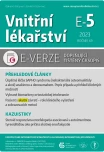Selected biomarkers of orthostatic intolerance
Authors:
Barbora Bačkorová; Ivica Lazúrová
Authors‘ workplace:
1. interná klinika UNLP a UPJŠ LF Košice
Published in:
Vnitř Lék 2023; 69(E-5): 15-19
Category:
doi:
https://doi.org/10.36290/vnl.2023.066
Overview
Orthostatic intolerance (OI) is defined as a group of diseases which symptoms are typically manifested in a standing position. These symptoms result from cerebral hypoperfusion and disappear in the supine position. We include postural orthostatic intolerance syndrome (POTS), orthostatic hypotension (OH) and vasovagal orthostatic syncope in this group of diseases. Each of them have similar clinical presentation (blurred vision, weakness, dizziness, nausea, headaches, fatigue). However, they vary from each other in biochemical, autonomic and hemodynamic characteristics.
The aim of the work is to provide an overview of humoral and non-human markers that are involved in the etiopathogenesis of orthostatic intolerance.
Keywords:
biomarkers – POTS – orthostatic intolerance – vasovagal syncope
Sources
- Gilmore S, Hart J, Geddes J, et al. Classification of orthostatic intolerance through data analytics. Med Biol Eng Comput. 2021;59(3):621-632.
- Freitas J, Azevedo E, Santos R, et al. Autonomic activity and biomarker behavior in supine position and after passive postural stress in different orthostatic intolerance syndromes. Rev Port Cardiol. 2015;34(9):543-9.
- van Dijk JG, van Rossum IA, Thijs RD. The pathophysiology of vasovagal syncope: Novel insights. Auton Neurosci. 2021;236:102899.
- Medic Spahic J, Ricci F, Aung N, et al. Proteomic analysis reveals sex-specific biomarker signature in postural orthostatic tachycardia syndrome. BMC Cardiovasc Disord. 2020;20(1):190.
- Frith J, Parry SW. New Horizons in orthostatic hypotension. Age Ageing. 2017;46(2):168-174.
- Jones PK, Shaw BH, Raj SR. Orthostatic hypotension: managing a difficult problem. Expert Rev Cardiovasc Ther. 2015;13(11):1263-76.
- Lei LY, Chew DS, Raj SR. Differential diagnosis of orthostatic hypotension. Auton Neurosci. 2020;228:102713.
- Wieling W, Kaufmann H, Claydon VE, et al. Diagnosis and treatment of orthostatic hypotension. Lancet Neurol. 2022;21(8):735-746.
- Fedorowski A, Ricci F, Sutton R. Orthostatic hypotension and cardiovascular risk. Kardiol Pol. 2019;77(11):1020-1027.
- Krishnan B, Benditt DG. Neuropeptides and peptide hormones in syncope and orthostatic intolerance. Cardiol J. 2014;21(6):591-600.
- Veazie S, Peterson K, Ansari Y, et al. Fludrocortisone for orthostatic hypotension. Cochrane Database Syst Rev. 2021;5(5):CD012868.
- Pektas A, Koken R, Koca HB. Serum vitamin B-12 in children presenting with vasovagal syncope. Asia Pac J Clin Nutr. 2018;27(1):176-181.
- Zhao J, Du S, Yang J, et al. Usefulness of plasma copeptin as a biomarker to predict the therapeutic effectiveness of metoprolol for postural tachycardia syndrome in children. Am J Cardiol. 2014;114(4):601-5.
- Lazurová Z, Čabrová M., Mitro P. Syndróm posturálnej ortostatickej tachykardie. Interná med. 2022; 22 (12):508-512.
- Benditt DG, van Dijk JG, Krishnappa D, et al. Neurohormones in the Pathophysiology of Vasovagal Syncope in Adults. Front. Cardiovasc. Med. 2020;7:76.
- Barbot, M., Ceccato, F., Zilio, M. et al. Cardiovascular autonomic dysfunction in patients with idiopathic diabetes insipidus. Pituitary. 2018; 21, 50-55.
- Zhang F, Li X, Ochs T, et al. Midregional pro-adrenomedullin as a predictor for therapeutic response to midodrine hydrochloride in children with postural orthostatic tachycardia syndrome. J Am Coll Cardiol. 2012;60(4):315-20.
- Plasek J, Doupal V, Furstova J, et al. The role of adrenomedullin and galanin in recurrent vasovagal syncope: a case control study. Biomed Pap Med Fac Univ Palacky Olomouc Czech Repub. 2013;157(2):162-7.
- Bai W, Han Z, Chen S, et al. Serum Resistin Negatively Correlates with Clinical Severity of Postural Tachycardia Syndrome in Children. Pediatr Cardiol. 2017;38(8):1639-1644.
- Mar, PL and Raj, SR. Neuronal and hormonal perturbations in postural tachycardia syndrome. Front. Physiol. 2014;5:220.
- Zhao J, Yang J, Du S, et al. Changes of atrial natriuretic peptide and antidiuretic hormone in children with postural tachycardia syndrome and orthostatic hypertension: a case control study. Chin Med J (Engl). 2014;127(10):1853-7.
- Stryjewski PJ, Nessler B, Kuczaj A, et al. The role of NT-proBNP in the diagnostics and differentiation of cardiac and reflex syncope in adults: relative importance to clinical presentation and medical examinations. J Interv Card Electrophysiol. 2014;41(1):1-8.
- Lin J, Han Z, Li H, et al. Plasma C-Type Natriuretic Peptide as a Predictor for Therapeutic Response to Metoprolol in Children with Postural Tachycardia Syndrome. PLoS ONE. 2015; 10(3): e0121913.
- Raziq H, Fayyaz H, Azhar R, et al. Association of serotonin levels in patients of vasovagal syncope and postural tachycardia syndrome. J Pak Med Assoc. 2021;71(8):1963-1966.
- Khan HF, Ambreen S, Raziq H, et al. Comparison of cortisol levels in patients with vasovagal syncope and postural tachycardia syndrome. Pak J Med Sci. 2022;38(1):185-189.
- Johansson M, Ricci F, Schulte J, et al. Circulating levels of growth hormone in postural orthostatic tachycardia syndrome. Sci Rep. 2021;11(1):8575.
- Annweiler C, Schott AM, Rolland Y, et al. Vitamin D deficiency is associated with orthostatic hypotension in oldest-old women. J Intern Med.;276(3):285-295.
- Duval GT, Paré PY, Gautier J, et al. Vitamin D and the Mechanisms, Circumstances and Consequences of Falls in Older Adults: A Case-Control Study. J Nutr Health Aging. 2017;21(10):1307-1313.
- Brignole M, Rivasi G. New insights in diagnostics and therapies in syncope: a novel approach to non-cardiac syncope. Heart. 2021;107(11):864-873.
- Brignole M, Groppelli A, Brambilla R, et al. Plasma adenosine and neurally mediated syncope: ready for clinical use. Europace. 2020;22(6):847-853.
- Stickford AS, VanGundy TB, Levine BD, et al. Menstrual cycle phase does not affect sympathetic neural activity in women with postural orthostatic tachycardia syndrome. J Physiol. 2015;593(9):2131-43.
- Prado M, Fiorelli EM, Tobaldini E, et al. An unusual syncope. Intern Emerg Med. 2013;8(1):65-7.
- Brignole M., Moya A., de Lange F. et al. 2018 ESC Guidelines for the diagnosis and management of syncope, European Heart Journal, 2018, 39, 21, 1883-1948.
Labels
Diabetology Endocrinology Internal medicineArticle was published in
Internal Medicine

2023 Issue E-5
Most read in this issue
- Successful treatment of SAPHO syndrome (chronic nonbacterial osteomyelitis and acne) with anakinra and denosumab. Case report and review of therapy
- The patient with acute vertigo – the role of clinical examination and imaging
- Selected biomarkers of orthostatic intolerance
- Steroid responsive encephalopathy associated with autoimmune thyroiditis as a cause of acuteencephalopathy
